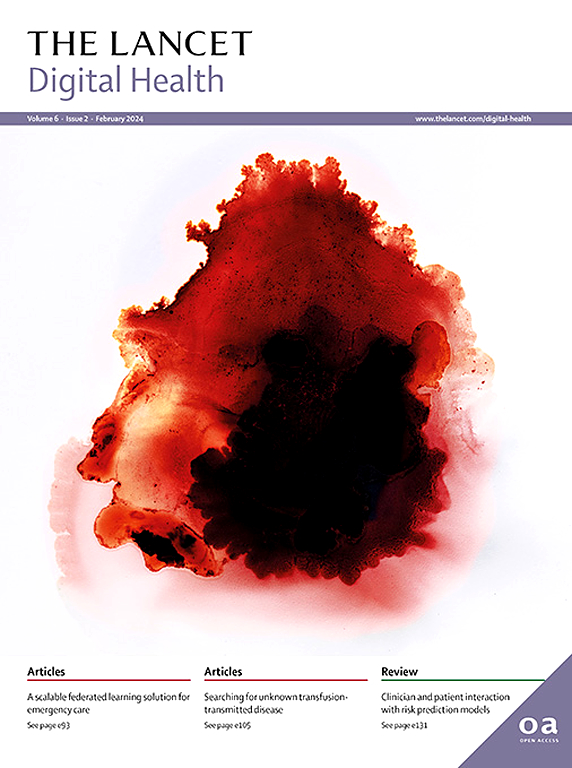Utilising the Benefit Risk Assessment of Vaccines (BRAVE) toolkit to evaluate the benefits and risks of Vaxzevria in the EU: a population-based study
IF 23.8
1区 医学
Q1 MEDICAL INFORMATICS
引用次数: 0
Abstract
Background
Several COVID-19 vaccines have been licensed. To support the assessment of safety signals, we developed a toolkit to support COVID-19 vaccine monitoring and benefit–risk assessment. We aim to show the application of our toolkit in the EU using thrombosis with thrombocytopenia syndrome (TTS) associated with the Vaxzevria (AstraZeneca) vaccine as a use case.
Methods
In this population-based study, we used a model incorporating data from multiple EU sources such as The European Surveillance System and EudraVigilance, and estimated the benefits of COVID-19 vaccines by comparing the observed COVID-19 confirmed cases, hospitalisations, intensive care unit (ICU) admissions, and deaths across Europe to the expected numbers in the absence of Vaxzevria vaccination. Risks of TTS associated with Vaxzevria were calculated by comparing the observed number of TTS events in individuals who received Vaxzevria to the expected number of events based on background incidence rates. To visualise the results, we developed a toolkit with an interactive web application.
Findings
62 598 505 Vaxzevria vaccines (32 763 183 to females and 29 835 322 to males) had been administered in Europe by Feb 10, 2021. Our results showed that a first dose of Vaxzevria provided benefits across all age groups. Based on vaccine effectiveness estimates and reported coverage in Europe, from Dec 13, 2020 to Dec 31, 2021, vaccination with Vaxzevria was estimated to prevent (per 100 000 doses) 12 113 COVID-19 cases, 1140 hospitalisations, 184 ICU admissions, and 261 deaths. Women aged 30–59 years and males aged 20–29 years had the highest frequency of TTS events. The benefits of vaccination outweighed the risks of TTS in all age groups, with the highest benefits and risks observed in individuals aged 60–69 years.
Interpretation
Our toolkit and underlying model contextualised the risk of TTS associated with Vaxzevria relative to its benefits. The methodology employed could be applied to other serious adverse events related to COVID-19 or other vaccines. The adaptability and versatility of such toolkits might contribute to strengthening preparedness for future public health emergencies.
Funding
European Medicines Agency.
利用疫苗获益风险评估(BRAVE)工具包评估欧盟Vaxzevria的获益和风险:一项基于人群的研究。
背景:几种COVID-19疫苗已获得许可。为了支持安全信号的评估,我们开发了一个工具包,以支持COVID-19疫苗监测和利益风险评估。我们的目标是展示我们的工具包在欧盟的应用,使用与Vaxzevria(阿斯利康)疫苗相关的血栓伴血小板减少综合征(TTS)作为用例。方法:在这项基于人群的研究中,我们使用了一个模型,该模型结合了来自多个欧盟来源(如欧洲监测系统和EudraVigilance)的数据,并通过比较欧洲各地观察到的COVID-19确诊病例、住院情况、重症监护病房(ICU)入院情况和死亡人数,与未接种Vaxzevria疫苗的预期数字,来估计COVID-19疫苗的益处。通过比较接受Vaxzevria的个体中观察到的TTS事件数量与基于背景发病率的预期事件数量,计算与Vaxzevria相关的TTS风险。为了使结果可视化,我们开发了一个带有交互式web应用程序的工具包。结果:截至2021年2月10日,欧洲共接种了62 598 505支Vaxzevria疫苗(女性接种32 763 183支,男性接种29 835 322支)。我们的研究结果表明,第一剂Vaxzevria对所有年龄组都有好处。根据疫苗有效性估计和欧洲报告的覆盖率,从2020年12月13日至2021年12月31日,估计接种Vaxzevria(每10万剂)可预防12113例COVID-19病例、1140例住院、184例ICU住院和261例死亡。30 ~ 59岁的女性和20 ~ 29岁的男性发生TTS的频率最高。在所有年龄组中,疫苗接种的益处超过TTS的风险,在60-69岁的个体中观察到的益处和风险最高。解释:我们的工具包和基础模型将与Vaxzevria相关的TTS风险与其益处相关联。所采用的方法可应用于与COVID-19或其他疫苗相关的其他严重不良事件。这些工具包的适应性和多功能性可能有助于加强对未来突发公共卫生事件的防范。资助:欧洲药品管理局。
本文章由计算机程序翻译,如有差异,请以英文原文为准。
求助全文
约1分钟内获得全文
求助全文
来源期刊

Lancet Digital Health
Multiple-
CiteScore
41.20
自引率
1.60%
发文量
232
审稿时长
13 weeks
期刊介绍:
The Lancet Digital Health publishes important, innovative, and practice-changing research on any topic connected with digital technology in clinical medicine, public health, and global health.
The journal’s open access content crosses subject boundaries, building bridges between health professionals and researchers.By bringing together the most important advances in this multidisciplinary field,The Lancet Digital Health is the most prominent publishing venue in digital health.
We publish a range of content types including Articles,Review, Comment, and Correspondence, contributing to promoting digital technologies in health practice worldwide.
 求助内容:
求助内容: 应助结果提醒方式:
应助结果提醒方式:


